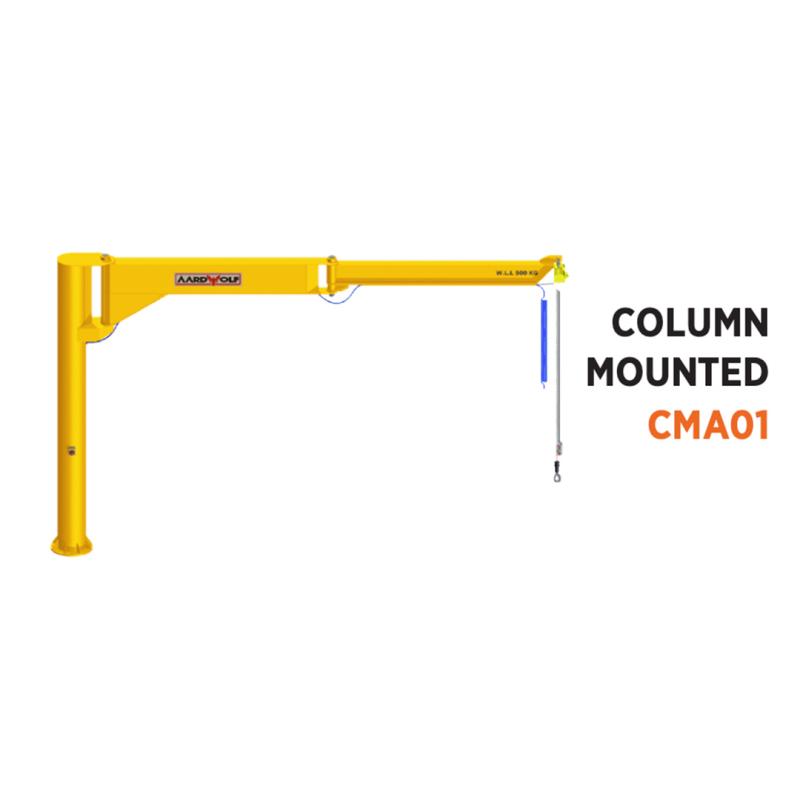



Unlike traditional straight-arm cranes, articulating jib cranes are designed with two pivot arms, allowing the crane to move loads around obstructions, into machines, and through confined or irregular spaces.
Part of the broader jib cranes family, these flexible lifting systems are particularly valuable in workshops, assembly lines, fabrication shops, and work cells where standard crane configurations fall short.
To explore the full line of Jib Cranes, including articulating, freestanding, ceiling-mounted, and wall-mounted options, visit Aardwolf’s dedicated product page.
An articulating jib crane features a segmented boom with at least two pivot points. These articulating arms enable multi-directional movement, allowing the operator to lift, move, and precisely position materials in complex environments. This makes them ideal for working around corners, through doorways, or into enclosures.
While traditional freestanding jib cranes offer broad rotational coverage, they struggle with navigating tight or crowded workspaces. The articulating version solves this by offering a flexible lifting radius, often exceeding 200 degrees of motion when both arms are engaged.
Need more context? Learn about the Difference between crane and jib cranes.
The hallmark of articulating jib cranes is their dual-arm articulation, which allows materials to be lifted in straight lines, around objects, or into areas where straight-arm jibs cannot reach.
These cranes are often equipped with manual or powered hoists, enabling smooth start-stop movement, positioning, and lowering of materials, essential for delicate operations such as equipment servicing or electronics assembly.
In tight work cells or workshops filled with machinery, articulating jib cranes eliminate the need for overhead cranes or forklifts. They help operators navigate within limited floor space without sacrificing lifting capacity.
Available in wall-mounted and floor-mounted configurations, articulating jib cranes can be adapted to a wide variety of structural settings. For example, the Articulated Jib Crane Wall Mounted is ideal for workstations where floor mounting isn't practical.
Articulating jib cranes are highly specialized and are used in situations where movement flexibility is paramount. Common use cases include:
Move loads into or out of machines, CNC stations, or presses—even when space is restricted.
Lift parts or welding jigs around barriers or structures with high control and precision.
Quickly move tools or parts from storage to workstations, often in repetitive cycles.
Ideal for operations in modular work cells, repair stations, or areas with multiple obstacles.
Explore more in The role of Jib Cranes.
How does the articulating jib crane compare with other jib cranes?
| Type | Movement | Ideal Use | Floor Space Use | Load Capacity |
|---|---|---|---|---|
| Articulating Jib Crane | Highly flexible | Confined, obstacle-filled environments | Low–Medium | Low–Medium |
| Freestanding Jib Crane | 360° rotation | Open spaces, central lifting zones | High | High |
| Wall Mounted Jib Crane | 180° rotation | Alongside walls or existing structures | Low | Medium |
| Ceiling Mounted Jib Crane | 180–360° | Work areas with floor space constraints | None | Medium |
| Pillar Jib Crane | 360° | Permanent heavy-duty lifting points | Medium–High | High |
These units mount directly to structural columns or concrete walls, offering flexibility without sacrificing floor space. This makes them ideal for workstation lifting tasks.
When wall support is unavailable, articulating jibs can be installed on steel columns or bolted directly to the floor with a base plate.
Looking for setup help? Review this complete guide on how to Prepare a jib crane.
Safety is critical when using any form of jib crane. Operators must understand how to:
Avoid overloading
Use proper rigging and lifting accessories
Perform regular maintenance and inspections
Ensure arm clearance and unrestricted pivoting
Articulating jib cranes offer unmatched flexibility in material handling—especially in environments where obstructions, machinery, or tight layouts challenge traditional lifting methods. By providing precise, controlled movement across multiple planes, these cranes improve workflow efficiency and reduce operator fatigue.
Whether mounted to a wall or a column, articulating jibs deliver ergonomic, reliable support in workshops, welding bays, and production lines. And when combined with Aardwolf’s full lineup of industrial lifting solutions, they become an essential tool in creating a smarter, safer, and more efficient workplace.
Ready to explore the best model for your space? Browse all Jib Cranes or talk to an expert about the right configuration for your application.
References
1. How to operate a Jib Cranes safely
3. Over brace jib crane wall mounted
5. Is a Jib Crane a Gantry Crane
6. Articulated Jib Crane Wall Mounted
8. Manual Counterbalance Crane
10. Over Braced Jib Crane Column Mounted
11. Powered counterbalance Crane
Sign up to receive the latest info on new Aardwolf products, special offers and more.
By signing up you agree to receive emails from Aardwolf with news, special offers, promotions and other information. You can unsubscribe at any time.